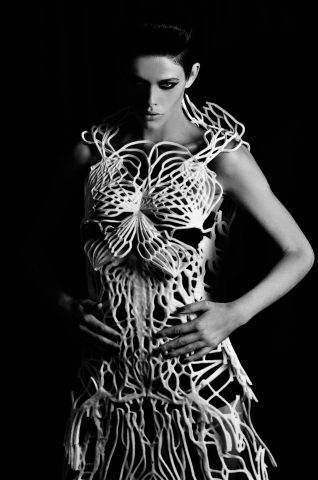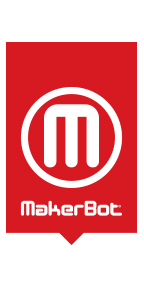BROOKLYN, N.Y.--(BUSINESS WIRE)--It’s Fashion Week in New York this week, and for MakerBot, the global leader in desktop 3D printing, that means it’s time to unveil a 3D printed fashion item and talk about an exciting new product in the world of filament. The Verlan Dress, designed in the New Skins: Computational Design for Fashion workshop led by designer Francis Bitonti of the famed Dita Dress, and held at the Pratt Institute’s DAHRC, is the first creation to ever use MakerBot Flexible Filament, a new adaptable filament material made out of polyester. MakerBot Flexible Filament, which will launch to the public soon (visit makerbot.com/flexiblefilament for more information), has a soft, flexible feel, and is even pliable when exposed to hot water (it can be reshaped and form-fitted).
“We are very excited about the development of MakerBot Flexible Filament,” said Bre Pettis, MakerBot’s CEO. Pettis noted that MakerBot Flexible Filament is a 1.75mm filament that flexes and moves after it is extruded into a 3D print. The material was commonly used for sutures in the medical field, mouth guards, prosthetics and non-woven fabrics. It is so versatile that it can be repurposed from its origin. Non-toxic and fully biodegradable, the MakerBot Flexible Filament provides a smooth finished surface and works well for form-fitted or personalized 3D prints. Pettis went on to say, “MakerBot Flexible Filament is different than traditional 3D printing filaments that are solid and stiff after extrusion; with its flexibility and suppleness, this could revolutionize 3D printing.”
MakerBot Flexible Filament is so malleable and form fitting that the Verlan Dress, created in Francis Bitonti’s New Skins workshop, uses mostly MakerBot Flexible Filament, with some traditional MakerBot PLA Filament on the chest and shoulder portions of the dress. The body of the dress is made entirely out of MakerBot Flexible Filament.
“For the New Skins workshops, the students were inspired by the lines of muscles in the human body and how muscle groupings are distributed,” noted Francis Bitonti, who led the workshop. “Through modeling, the students came up with new forms for the dress. For the material, we needed something that would be able to conform to the body. If it were rigid, the flow and feel of the body’s muscles wouldn’t be possible – it would be like armor. We needed this material to flex and move with movement, like muscles do, and MakerBot’s Flexible Filament worked beautifully for the design.”
Bitonti’s New Skins workshop was the first application outside of the company’s R&D facility to use MakerBot Flexible Filament. The New Skins workshop printed the whole Verlan Dress using two MakerBot Replicator 2 Desktop 3D Printers. The MakerBot Replicator 2s printed continually for close to 24 hours a day for two weeks – a total of 400 hours of printing – to create the dress. Francis Bitonti is an experienced 3D printed fashion designer, but this was the first time he had an actual 3D printer in his studio.
“I was pleasantly surprised with how easy the MakerBots were to use,” said Bitonti. “The quality was on par with any industrial 3D printed pieces we have commissioned previously. It was great to have the MakerBot Desktop 3D Printers in the studio and provided the students the ability to have immediate feedback on their designs by printing them during the design process.”
Bitonti’s students used Autodesk’s Maya software, along with Rhino and ZBrush, to create their designs. The resulting Verlan Dress will be featured in a documentary video on the New Skins workshop design process and will be showcased at a Bitonti exhibit later this fall at the Pratt Institute in New York City. The dress’ design is posted on Thingiverse.com.
To learn more about the new MakerBot Flexible Filament, sign-up for updates on makerbot.com/flexiblefilament. To download and print the Verlan Dress, visit Thingiverse.com.
About MakerBot
MakerBot, a subsidiary of Stratasys, Ltd., is leading the Next Industrial Revolution by setting the standards in reliable and affordable desktop 3D printing. Founded in 2009, MakerBot has built the largest installed base of desktop 3D printers sold to innovative and industry-leading customers worldwide, including engineers, architects, designers, educators and consumers. MakerBot’s 3D Ecosystem drives accessibility and rapid adoption of 3D printing and includes: Thingiverse.com, the MakerBot Digitizer Desktop 3D Scanner, the MakerBot Replicator line of Desktop 3D Printers, MakerWare software, MakerCare, the MakerBot retail store, and strategic partnerships with top-tier brands. MakerBot has been honored with many accolades, including Popular Mechanics’ “Overall Winner” for best 3D printer, Time Magazine’s “Best Inventions of 2012,” Popular Mechanics’ “Editor’s Choice Award,” Popular Science’s “Product of the Year,” Fast Company’s “One of the World’s Top 10 Most Innovative Companies in Consumer Electronics,” and many more. Join the Next Industrial Revolution by following MakerBot at makerbot.com.
About Stratasys
Stratasys Ltd. (Nasdaq: SSYS), headquartered in Minneapolis, Minn. and Rehovot, Israel, manufactures 3D printers and materials for prototyping and production. The company’s patented FDM® and PolyJet® processes produce prototypes and manufactured goods directly from 3D CAD files or other 3D content. Systems include 3D printers for idea development, prototyping and direct digital manufacturing. Stratasys subsidiaries include MakerBot and Solidscape and the company operates the RedEye On Demand digital-manufacturing service. Stratasys has more than 1500 employees, holds over 500 granted or pending additive manufacturing patents globally, and has received more than 20 awards for its technology and leadership. Online at: stratasys.com or blog.stratasys.com




